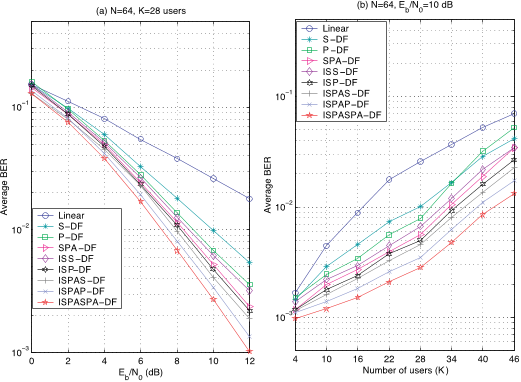




Did you find this useful? Give us your feedback














236 citations
...However, these decision-driven detection algorithms suffer from error propagation and performance degradation....
[...]
183 citations
...These systems implemented with direct-sequence (DS) signaling are found in third-generation cellular telephony [7]–[9], indoor wireless networks [10], satellite communications, and ultrawideband technology [11] and are being considered for future systems with multicarrier (MC) versions such as MC-CDMA and MC-DS-CDMA [12] and in conjunction with multiple antennas [13]....
[...]
...The structure of the M × L matrices C̄k, Ck, and C̃k is detailed in [9]....
[...]
181 citations
...The DF strategy that is adopted in this paper is the parallel scheme reported in [9] and [ 13 ], which first obtains the decision vector ˆ xT,j[i] with linear equalization and then employs ˆ xT,j[i] to cancel the interference that is caused by the interfering streams....
[...]
163 citations
...When channel state information (CSI) is available at the receiver, this interference can be mitigated by the use of successive interference cancelation (SIC) and equivalent techniques, such as the vertical Bell-Labs layered space–time and multibranch implementations [11]–[15]....
[...]
158 citations
8,781 citations
[...]
5,048 citations
2,300 citations
...Recently, Verdu and Shamai [7] and Rapajic [8]et al. have investigated the information theoretic trade-off between the spectral and power efficiency of linear and non-linear multiuser detectors in synchronous AWGN channels....
[...]
...[2] S. Verdu, “Minimum Probability of Error for Asynchronous Gaussian Multiple-Access Channels”,IEEE Transactions on Information Theory, vol.IT-32, no. 1, pp. 85-96, Janeiro, 1986....
[...]
...REFERENCES [1] S. Verdu, Multiuser Detection, Cambridge, 1998....
[...]
...The optimal multiuser detector of Verdu [2] suffers from exponential complexity and requires the knowledge of timing, amplitude and signature sequences....
[...]
...[7] S. Verdu and S. Shamai, “Spectral efficiency of CDMA with random spreading,”IEEE Transactions on Information Theory, vol. 45, pp. 622- 640, 1999....
[...]
2,098 citations
...This extrinsic information is the information about the code bit bk(i) obtained from the prior information about the other code bits λp1[bk(j)], j = i [22]....
[...]
...This assumption is reasonable when there are many active users, has been used in previous works [15],[22]-[23] and provides an efÞcient and accurate way of computing the extrinsic information....
[...]
1,609 citations
...This fact has motivated the development of various sub-optimal strategies: the linear [3] and decision feedback (DF) [4] receivers, the successive interference canceller [5] and the multistage detector [6]....
[...]
The motivation for the proposed encoded structure is that significant gains can be obtained from iterative techniques with soft cancellation methods and error control coding [17]-[23] and from efficient receivers structures and ordering algorithms such as the novel SPA-DF detector.
The role of reversing the cancellation order in successive stages is to equalize the performance of the users over the population or at least reduce the performance disparities.
In particular, the feedback filter fk(i) of user k has a number of non-zero coefficients corresponding to the available number of feedback connections for each type of cancellation structure.
The ISPAP-DF scheme can save up to 1.4 dB and support up to 8 more users in comparison with the ISP-DF for the same BER performance.
the ISPASPA-DF detector can save up to 1.8 dB and support up to 10 additional users in comparison with the ISP-DF for the same BER performance.
2. The proposed iterative (turbo) receiver structure consists of the following stages: a soft-input-soft-output (SISO) SPA-DF detector and a maximum a posteriori (MAP) decoder.
It is worth noting that the linear and P-DF detectors experience performance losses for coded systems, relative to the other structures, as verified in [14] and which is a result of the loss in spreading gain that increases the interference power at the output of the MMSE receiver.
An iterative receiver with hard-decision feedback is defined by:z(m+1)(i) = WH(i)r(i) − FH(i)b̂(m)(i) (23)where the filters W and F can be S-DF or P-DF structures, and b̂m(i) is the vector of tentative decisions from the preceding iteration that is described by:b̂(1)(i) = sgn ( ℜ [ WH(i)r(i) ])(24)b̂(m)(i) = sgn ( ℜ [ z(m)(i) ]) , m > 1 (25)where the number of stages m depends on the application.
The MAP decoder also computes the a posteriori LLR of every information bit, which is used to make a decision on the decoded bit at the last iteration.
Iterative Turbo Receiver and DecodingA CDMA system with convolutional codes being used at the transmitter and the proposed iterative SPA-DF receiver with turbo decoding is illustrated in Fig.
For this reason, the authors adopt L = 4 for the remaining experiments because it presents a very attractive trade-off between performance and complexity.
From the curves, the authors observe that a disadvantage of S-DF relative to PDF is that it does not provide uniform performance over the user population.
The decoding of the proposed iterative detection schemes that employ the SPA-DF detector (ISPAS-DF, ISPAP-DF and ISPASPA-DF) resembles the uncoded case, where the second stage benefits from the enhanced estimates provided by the first stage that now employs convolutional codes followed by a Viterbi decoder with branch metrics based on the Hamming distance.
These estimates are used to compute the detector a posteriori probabilities P [bk(i) = ±1|z(m)k (i)] which are deinterleaved and input to the MAP decoder for the convolutionalcode.
As occurs with S-DF receivers, a disadvantage of the SPA-DF detector is that it generally does not provide uniform performance over the user population.
This is an important feature of the proposed detectors as they can save considerable computational resources by operating with a lower number of turbo iterations.